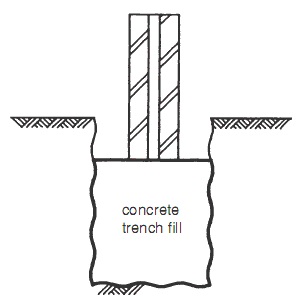Trench fill foundation
Trench fill foundations are a type of shallow foundation that avoids bricklaying below ground by instead almost completely filling the trench excavation with concrete. Typically, concrete is poured to within 150 mm of the surface ground level. This type of foundation minimises the excavation required, as bricklayers are not required to access the trench to lay bricks or blocks. It can also help to reduce the width of the foundation where below ground brickwork would require a wider footing.
Trench fill is often used when soil is loose or in areas with a high water table, although in loose ground it can be difficult to predict the quantity of concrete required, and the quantity can be quite high if trenches meet or cross at right angles.
By getting ‘out of the ground’ relatively quickly, trench fill foundations can save on labour, time and temporary works.
Trench fill foundations can be taken deeper in areas with heavy clay or in the presence of trees, to a level where the subsoil moisture content is unaffected. In these situations, mesh reinforcement is often required. In addition, one or both trench faces may need to be lined with a compressible batt. This can also mitigate against the tendency in some situations for the trench strips to pick up longitudinal or lateral ground strains which may occur in the strata immediately around the foundation.
Another issue to consider is that the height of the concrete can create access problems for drainage and other services, as well as issues with landscaping and planting.
A variation on the trench fill foundation is the Rubble trench foundation.
[edit] Related articles on Designing Buildings
Featured articles and news
One of the most impressive Victorian architects. Book review.
RTPI leader to become new CIOB Chief Executive Officer
Dr Victoria Hills MRTPI, FICE to take over after Caroline Gumble’s departure.
Social and affordable housing, a long term plan for delivery
The “Delivering a Decade of Renewal for Social and Affordable Housing” strategy sets out future path.
A change to adoptive architecture
Effects of global weather warming on architectural detailing, material choice and human interaction.
The proposed publicly owned and backed subsidiary of Homes England, to facilitate new homes.
How big is the problem and what can we do to mitigate the effects?
Overheating guidance and tools for building designers
A number of cool guides to help with the heat.
The UK's Modern Industrial Strategy: A 10 year plan
Previous consultation criticism, current key elements and general support with some persisting reservations.
Building Safety Regulator reforms
New roles, new staff and a new fast track service pave the way for a single construction regulator.
Architectural Technologist CPDs and Communications
CIAT CPD… and how you can do it!
Cooling centres and cool spaces
Managing extreme heat in cities by directing the public to places for heat stress relief and water sources.
Winter gardens: A brief history and warm variations
Extending the season with glass in different forms and terms.
Restoring Great Yarmouth's Winter Gardens
Transforming one of the least sustainable constructions imaginable.
Construction Skills Mission Board launch sector drive
Newly formed government and industry collaboration set strategy for recruiting an additional 100,000 construction workers a year.
New Architects Code comes into effect in September 2025
ARB Architects Code of Conduct and Practice available with ongoing consultation regarding guidance.
Welsh Skills Body (Medr) launches ambitious plan
The new skills body brings together funding and regulation of tertiary education and research for the devolved nation.
Paul Gandy FCIOB announced as next CIOB President
Former Tilbury Douglas CEO takes helm.
























